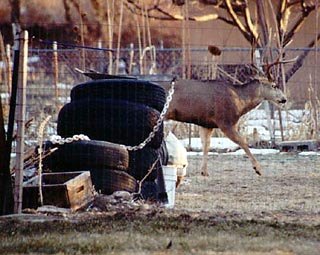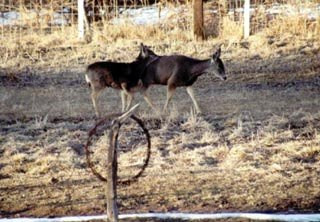Wintertime Visitors
By: Mike Radford (Utah)

|
In addition to reduced forage in the mountains, urban sprawl has pushed our homes into traditional wintering grounds for these animals, further reducing the options for the deer. They have been forced to either co-exist with man or become extinct. They have no-where else to go.
While mule deer herds are currently being hard hit by the intrusion of man, it was only a century ago that deer herds expanded rapidly from man’s presence. Mule deer thrive in the fringes between prairie and desert. With man cultivating desert, grazing the prairie and logging the forests, additional brushy habitat became available to them and their populations grew rapidly. Not only have mule deer found Utah a desirable place to live, but so have we and now our own population explosion is causing a reduction of Utah deer herds.
Most of us are delighted to see these beautiful animals until we notice that just about the time the tulips bloom they have become deer salad. Some warm hearted individuals feel for the plight of the deer in their area and want to help. Many well-meaning individuals set out to feed the deer. This may well be a perfect example of “loving them to death”.

|
With the deer coming very close to us it is tempting to see just how close we can get. It is important to remember that these animals are wild and would not normally allow us to get close to them. In many cases these animals are highly stressed due to poor nutrition, cold conditions, and living in close proximity to man. Causing them any additional stress or exertion eliminate any available reserves and cause irreparable harm. If we encounter these animals we should take care to not disturb them or allow our pets to harass them in any way. Most of the animals that come into our neighborhoods during heavy snowfall will return to their winter grounds if they are not frightened and pushed further into civilization.
If excessive damage to your property is occurring you can contact the Division of Wildlife Resources for their advice and/or assistance. Through patience and understanding of these graceful and beautiful animals we can strike a balance where all can continue to live in and enjoy this great land.
More information on mule deer and other species can be found on the internet at the Utah DWR website.
Click-a-Pic ... Details & Bigger Photos
Click-a-Pic ... Details & Bigger Photos
Videos | Hunts & Tags | About Mule Deer | About Elk
Classified Ads | Photo Tours | About this Site | Advertising |
Older Content | Email Us | Privacy Policy
